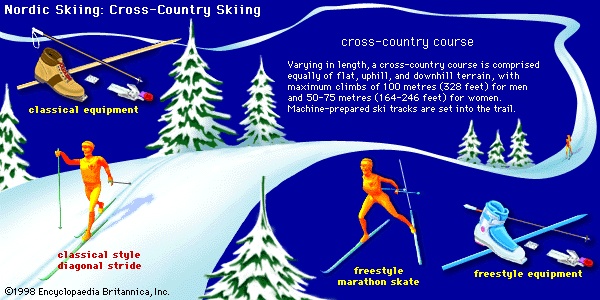cross-country skiing
sport
skiing in open country over rolling, hilly terrain as found in Scandinavian countries, where the sport originated as a means of travel as well as recreation and where it remains popular. In its noncompetitive form the sport is also known as ski touring.
The skis used are longer, narrower, and lighter than those used in more-mountainous, Alpine-type terrain. In addition, the bindings allow movement between the heel of the skier's boot and the ski, and the ski poles are longer than those used in Alpine skiing. There are two techniques of cross-country skiing. Using the older classical technique, a skier travels with skis parallel and kicking backward to create a gliding motion across the snow. The more-recent skating, or freestyle, technique, developed in the 1970s, closely resembles the motions of ice skating. With this technique the skier pushes the inside edge of the ski simultaneously backward and outward at about a 45° angle, thereby generating more speed than with the classical style.
 Cross-country races (also called langlauf in German and langrenn in most Scandinavian languages), or Nordic races, are held over somewhat circular courses. The standard lengths of international races are 10, 15, 30, and 50 km for men and 5, 10, 15, and 30 km for women. Many traditional contests are longer—the Vasaloppet in Sweden is 90 km (56 mi). Race organizers may stipulate which of the skiing techniques are permitted in an event. Contestants usually begin at intervals, and lowest time determines the winner.
Cross-country races (also called langlauf in German and langrenn in most Scandinavian languages), or Nordic races, are held over somewhat circular courses. The standard lengths of international races are 10, 15, 30, and 50 km for men and 5, 10, 15, and 30 km for women. Many traditional contests are longer—the Vasaloppet in Sweden is 90 km (56 mi). Race organizers may stipulate which of the skiing techniques are permitted in an event. Contestants usually begin at intervals, and lowest time determines the winner.In a cross-country relay race, four men each ski a 10-km course, or four women a 5-km course. Cross-country competitions also include pursuit races. A pursuit event is held over two days. On the first day the skiers compete in a traditional cross-country race, but on the second day the skiers' starts are staggered according to the times of the previous day. The pack chases the leader and the first across the finish line wins. Cross-country skiing is not as dangerous as other skiing events, but it demands much stamina, especially for the longer distances.
- Lepchā
- Le Pen, Jean-Marie
- Le Petit-Quevilly
- Lepidodendron
- lepidolite
- lepidopteran
- Lepidozamia
- Lepidus, Marcus Aemilius
- Le Play, Frédéric
- Lepontine Alps
- Le Port
- Le Poulain, Jean
- leprechaun
- leprosy
- Lepsius, Richard
- Leptaena
- Leptines, Law of
- Leptis Magna
- Leptis Minor
- leptochlorite
- Leptodactylidae
- Leptodesma
- Leptodus
- Leptolepis
- lepton